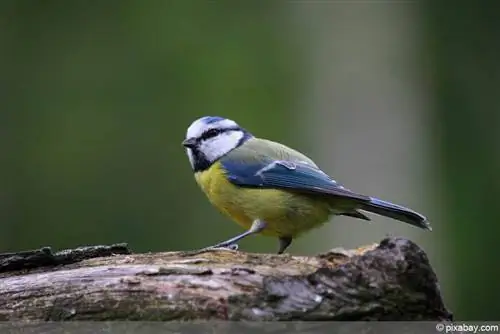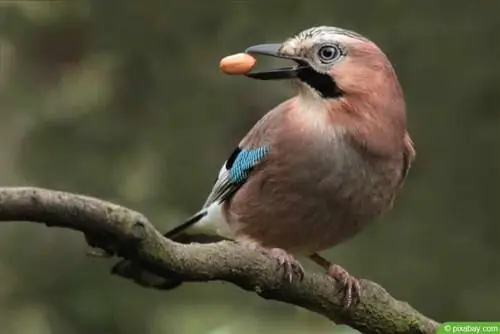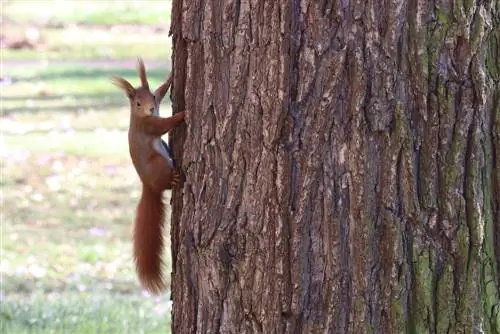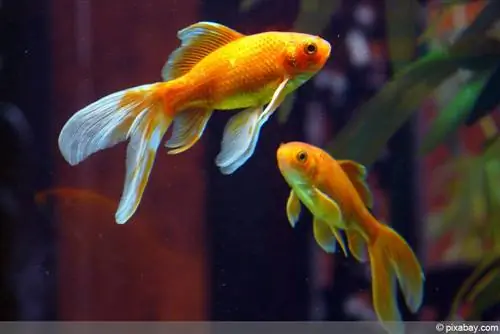- Author admin [email protected].
- Public 2023-12-17 03:39.
- Last modified 2025-01-24 12:45.
If winter isn't quite over yet, the first sounds of the blue tits can already be heard. The blue tit is considered to be relatively robust, but both the winter and its enemies make its chances of survival much more difficult. So that this unique bird species can enchant its surroundings with its song and colorful plumage for decades or even longer, you should find out everything you need to know below. In addition, you will learn from professional tips how you can behave in which situation.
Profile
- Name: Blue Tit
- Scientific name: Cyanistes caeruleus
- Genus: Cyanistes
- Occurrence: almost throughout Europe, Asia, Africa
- Size: Length between 62 millimeters and 71 millimeters
- Weight: between 11 grams and 12.1 grams
- Plumage: predominantly blue-yellow with accents in white and gray
- Food: mainly animal
- Average age: five years
Detection
The blue tit is very striking in its colorful plumage and can usually be easily distinguished from other birds. The back area and the wings are in a steely blue, which changes to a “washed out” gray towards the neck, interrupted by a light blue “neck band”. The wings are white on the underside.
The head usually has a blue “cap” and then white runs over it.
The black stripe that runs from the side of the eyes and horizontally towards the neck is particularly noticeable. The white cheeks end in the lower area with a black collar, which is followed by the yellow belly area and the yellow color extends to the flanks. The beak is very short and dark brown to black in color. The legs are light gray. Basically the female is a little smaller and lighter than the male.
Mauser
Moulting is a change of feathers and is normal for most bird species. Nature makes differences between the moulting of young animals and adult blue tits.
Young Tit
After the young tit has received its first feathers as a nesting stool, it loses it in different stages. The pale yellow plumage in the head area changes at the end of the so-called juvenile wall between mid-July and the end of October of the first year of life. The young blue tit loses the first feathers on its torso and wings until the 18th day after hatching, when it fledges. Here the plumage takes on a clearly more recognizable coloring, which is typical of the blue tit, but only intensifies in the second year of life and is then no longer distinguishable from the old tit.
Adults
The adult tree ants go through a full moult once a year. In technical jargon, the beginning is called “postnupial”, which means “after the wedding”. This means that the first full moult only takes place once the first mating has taken place, which is usually the case in the following year after hatching. This is followed every year by the annual moult, approximately six weeks before the partial moult of the young. The moult usually begins while the young are being reared. The full molt lasts an average of 120 days, which is a long time for birds.
Singing
The Cyanistes caeruleus has a very varied song and is highly recognizable. This bird species usually starts its song with a high-pitched “tii-tii” and then transitions into a verse-rich trill. The so-called district singing is particularly diverse. The blue tits also sing “tii-tii” three times, although this is sung much lower than in normal singing.
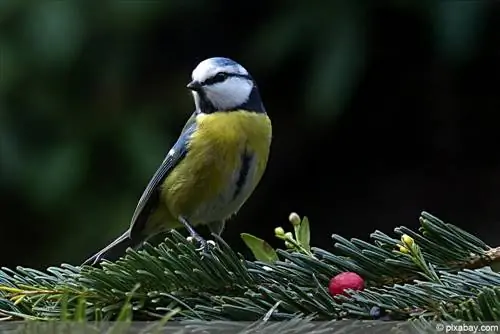
This is followed by between five and 25 short trill blocks. These are mostly the same length, but can be accompanied by longer verse passages, especially in the middle part of the song. If this is the case, shortened verses usually follow. The territorial song draws attention to oneself long before the actual mating season.
Food
Blue tits feed primarily on animal products that they find in nature, especially when raising their young. From autumn to spring they also switch to plant-based food. Your menu includes, among other things:
- worms
- Spiders
- Various small insects
- Larvae
- Seeds
- Berries
The Cyanistes caeruleus proves to be clever and clever, especially when looking for food or obtaining food. For example, it often tricks sparrows or scares away smaller songbirds from a food source. Especially in winter, she doesn't stop at stealing the nuts from the hiding places of jays, which takes a lot of courage, because the jay is one of the natural predators of the blue tits.
Predators
As popular as this species of tit is among people due to its colorful colors and sonorous song, it is also popular in the animal world as a food offering. Many young animals lose their lives, especially in the first year of life.
The following predators are among the greatest life-threatening dangers:
- Peregrine Falcons
- Parasites
- Sparrowhawk
- Cats
- Corvids
- Jay
In addition, humans are another source of danger. In some regions the blue tit is considered a real delicacy on the menu, while they are also often the target of many air rifles, which their small body cannot withstand.
Propagation
First pairing
Blue tits usually reach sexual maturity before they reach their first year of life. It can happen that female young animals lay their first eggs as early as ten months old, although this is less common. However, it is usual for the first mating to take place in the second year of life. According to estimates, the mating rate for one-year-old young tits is less than 30 percent.
Mating season
As early as mid-January, the male blue tits can often be observed expressing their interest in female tits to potential competitors by driving them away from the immediate vicinity. They attract females with their territorial song, which can last until March. A second mating season can occur in July, but this is quite rare.
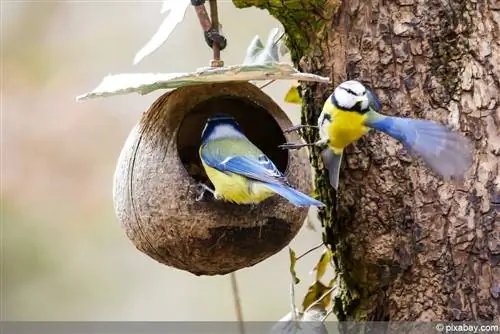
Eggs
The first eggs of the current year will be laid by the end of April. There are usually between five and 15 eggs. These are minimally shiny, have a smooth surface and have red brown-red dots/spots of varying intensity. They also have a spindle shape that is typical of titmice. As a rule, one egg is laid every 24 hours.
Brood
Once the eggs are laid, the female goes to brood. Researchers have determined an average breeding time of 26 minutes. She then leaves the nest for about ten minutes and warms the eggs again. These times may vary depending on the ambient temperature.
The colder it is, the shorter the breeding interruptions become. However, the average breeding duration remains. During breeding, the male blue tit is always in the immediate vicinity. It looks out for possible dangers in the breeding territory and feeds the female while breeding.
Breeding period
The total incubation period is between 13 and 15 days. The young tits then hatch as so-called nest stools. This means they are born without feathers and their eyes and ear canals are closed.
Young bird development
Once the offspring hatch, the initial development progresses quite quickly:
- After about a week the first partial plumage will grow
- At the same time the eyes and ear canals open
- This is quickly followed by the “feeding cry” of the nest stools
- Male now also do the feeding
- From the eighth day onwards, both sets of parents feed the same amount
- Greatest food requirement between the 11th and 15th day
- Plumage completes by the 18th day
- Leaving the nest: approximately between the 18th day and 22nd day
If the male has another brood from another female, he usually switches between the breeding sites. Accordingly, the length of time he stays at the respective locations and the number of times he takes over feeding the young is reduced.
Nest
Once the male has found his territory to look for his mating partner, he also scouts the surrounding area for a suitable nest site. To do this, he focuses primarily on all types of caves, which can be found particularly in trees and walls. It is not uncommon for them to take over burrows previously used by woodpeckers that are unused. Blue tits also like to accept nesting boxes built by people. Once mating has occurred, the male leads the female to the breeding site.
Here only the female designs the nest. This requires blades of grass, moss, small twigs as well as animal hair and feathers. The construction period usually lasts two days. If danger becomes apparent, a new nest site is sought, so the time can be delayed up to 14 days until a nest in a safe place is ready for breeding. The shape of the nest has a special feature.
This is less taken into account during construction, but rather the female lies on the upper layer and pushes and pushes herself back and forth until she has pushed the inner area outwards. This creates a small hollow in which the eggs lie deep in the nest and cannot fall out.
Tip:
If an egg falls out, carefully place it back in the nest. However, you should wait until the female stops breeding and does not see you approaching the nest.
Wintering
The blue tit is a migratory and resident bird. This means that some move south as autumn approaches, while others remain in Central Europe. This species of tit usually makes its way from the cold north to the warm Mediterranean in September. Anyone who stays in Central Europe prepares themselves as best they can for the freezing temperatures. However, the blue tits rely on people's help, especially in snow-covered landscapes. Even if this is done extensively, not every bird survives the winter period.
Winter quarters
Birds like Cyanistes caeruleus have a higher body temperature than mammals, at 39 to 40 degrees Celsius. This means that they freeze to death more quickly, which is why they would not survive the winter in places that are not protected from wind or cold, such as on a branch. The remarkable thing about them is that they still don't look for winter-friendly quarters. Sexually mature and mating blue tits establish their mating territory in autumn and the males look for the optimal breeding cavity.
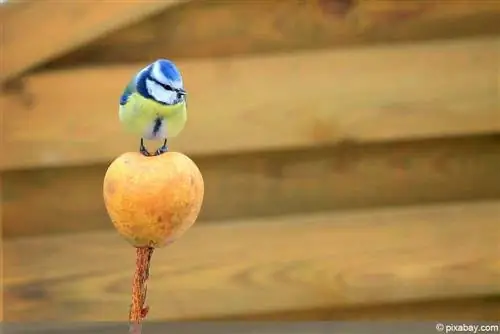
It is not uncommon for them to already have a mating partner at their side, with whom the male settles down at the onset of winter. They hug each other and warm each other. Since not all of these bird species have found breeding grounds before the start of winter or do not yet have a possible mating partner, the chance of freezing to death is extremely high. For this reason, nesting aids are essential in winter to offer these specimens a protected place to overwinter.
Tip:
If you have neglected to clean your permanently installed nesting box by mid-autumn, please do not do so. The little blue birds are only drawn to natural roosts and cleaning products or completely clean nesting boxes and are not welcome for overwintering.
Body Functions
Due to the high body temperature, cold is extremely detrimental to the body and its function. In conclusion, this leads to excessive energy consumption. In order to at least reduce this a little or not allow it to increase even further, these songbirds behave relatively calmly in the cold winter months. As a rule, they only leave their quarters to look for food, without which they cannot survive because then their body functions cannot be maintained. Only appropriate food can give them back the energy they have lost. However, the supply of food is significantly limited in winter.
Winter feeding
In order to balance the energy consumption caused by cold temperatures as well as possible, a diet rich in fat is of great importance for the blue tit species. This is usually not found in the wild, which is why it has to rely on artificial food in the form of special suet balls, for example. Although she can find various berries or seedlings in winter, these provide the body with little to no energy.
Tip:
Do not buy suet balls that are hung in a plastic net. The birds can get caught in here and, in the worst case, get badly injured. It is better to have a special food dispenser or food box in which you can crumble a suet ball if necessary.
Conclusion
Tits are among the songbirds with the most distinctive and sonorous singing voices. They are also pretty to look at due to their intense color and the harmonious play of colors between yellow and blue. They enrich nature in wonderful ways. Countless numbers of them die every year. Very few make it past the age of two because they fall prey to their enemies, become ill or do not survive the winter. With your help, the risk of death can be reduced and the blue tits can be offered better living conditions, especially with regard to breeding sites, through nesting aids.

